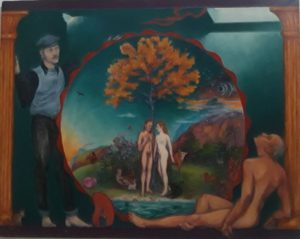America’s longest-running yearly art show, The National Academy of Design’s Annual Exhibition, is on view once again. This is the 167th such show staged by the venerable academy, and, as always, it’s a meditation on the meaning of tradition in the present-day art world.
There is no such thing as art without a tradition, but just what is ours? Judging by what is seen at the Whitney Biennial, many believe that art began with Andy Warhol, or maybe Marcel Duchamp.

Anthony Santuoso’s “A Creation Story: Resolution.”
See this, then, as the antidote to the Whitney. The artists of the National Academy are not afraid to draw from art history. They are open to new syntheses —incorporating lessons from modern masters as well as artists from the Renaissance or the 19th century.
Of course, it’s doubtful that academy founder Samuel F. B. Morse (the inventor of the telegraph and also a painter), would understand what academic standards are being maintained by today’s academy. But he would be even more confused by today’s topsy-turvy culture, in which what was once the avant-garde — pop, minimalism, conceptualism, neo-geo and whatever —is now the establishment, and artists who aspire to the otherworldliness of the Renaissance or the passionate expressiveness of Van Gogh, are the rebellious outsiders.
The problem faced by the artists in this show, then, is what to draw from the grand tradition and how to bring something new to it. Most of the artists here resist the contemporary draw of superficial novelty and shock value. However, too many have erred on the other side, never evolving past role models like Bonnard or Monet. They fail to put their own stamp on it.
Rosemarie Beck is one who has successfully bridged past and present. Her Cezannesque patchwork compositions of figures and landscapes can, like the best abstract paintings, persuade you that that the beauty of paint hue and texture can carry the day.
Most of the artists here are image makers. They are not necessarily realists, but they are committed to making pictures.
Some do this while leaning toward near abstraction, like Judy Cutler. In her New York cityscapes, blocks of color slip, slide, and clink against one another like musical notes.
Others have little stories to tell, like Patti McManus in “Mugging.” Painted in drab browns and steely grays, the picture of a subway purse-snatching has a matter-of-factness about it, as if to reflect contemporary society’s habituation to lawlessness.
Myron Heise works in the tradition of the early 20th century Ashcan School. His raucous treatment of the San Genarro festival captures the fleshy, tawdry side of Little Italy’s annual street fair and, ironically, given its church sponsorship, turns it into something out of the biblical city of Gomorrah.
What to say about super-realists like Paul Fortunato or Daniel J. O’Neil? Their self-portraits revel in every vein, pore, follicle, and nostril hair. In late 19th century France, when painters felt challenged to do photography one better, such obsessive verisimilitude might have made sense. Today, not so much.
This is a big show, with 300 paintings arrayed across the Academy’s three-floor warren of galleries. With no unifying theme, the vast display of stylistic possibilities can wear you down. Who can make himself heard in this crowd? At times, the paintings themselves exude weariness as with Joe Greenberg’s “Figures in an Interior,” in which an old man stares off into space with the resignation of Arthur Miller’s tragic salesman, Willy Loman.
Every great work must look as if it could have come from no other time than its own.
Lots here have a “now” feeling about them. There’s the funky cartoonishness of Carmen Cicero’s “Death Hails a Cab.” It’s bold and amusing, but never rises above the low art of comic strips.
At the other extreme is Steve Brown’s “Study for Eight Cows,” which almost seems a kind of dare, as if an artist had set out to prove that a pedestrian 17th-century subject painted in a 19th-century style could be valid in a late 20th-century exhibit. One searches in vain for the ace-in-the-hole that will back up the claim.
There are any number of beautiful small paintings in this show. Somewhere, on any given day, an artist in some studio gets lucky and produces a flawless gem, like the lyrical, near-abstract still life by Stanley Lewis.
There are even a few medium-sized paintings with considerable charm, like Larry Mizrahi’s quirky black still life. This is a sly and playful painting. Up close, one sees that the objects on the table are just daubed on against the black background, and yet everything in the painting clicks: the cat’s face, the candle in the dish, the art book, the four yellow table legs.
Rarer still are those ambitious paintings in which the artist is trying to go beyond charm or a successful composition, and into the realm of ideas.
Anthony Santuoso’s “A Creation Story—Resolution” is a picture that harks back to the Adam and Eve story. The image of the Garden of Eden appears within a kind of magic circle, outside of which are two contemporary figures. One is nude and asleep, one clothed and awake, both with artist’s tools in their hands. There’s a hint of New Age mysticism in this work, but it’s a painting that deals with myth, symbolism, and states of consciousness, just as the religious works of the past once did. It’s a picture that rewards sustained contemplation, never yielding all its secrets.
National Academy of Design
1992

